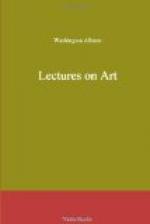The variety of objects which this new course of life each day presented, brought me at length to a state of sanity; at least, I was no longer disposed to conjure up remote dangers to my door, or chew the cud on my indigested past reading; though sometimes, I confess, when I have been tempted to meddle with a very bad character, I have invariably been threatened with a relapse; which leads me to think the existence of some secret affinity between rogues and boa-constrictors is not unlikely. In a short time, however, I had every reason to believe myself completely cured; for the days began to appear of their natural length, and I no longer saw every thing through a pair of blue spectacles, but found nature diversified by a thousand beautiful colors, and the people about me a thousand times more interesting than hyenas or Hottentots. The world is now my only study, and I trust I shall stick to it for the sake of my health.
Footnotes
[1] The Frightful is not the Terrible, though often confounded with it.
[2] See Introductory Discourse.
[3] There is one species of imitation, however, which, as having been practised by some of the most original minds, and also sanctioned by the ablest writers, demands at least a little consideration; namely, the adoption of an attitude, provided it be employed to convey a different thought. So far, indeed, as the imitation has been confined to a suggestion, and the attitude adopted has been modified by the new subject, to which it was transferred, by a distinct change of character and expression, though with but little variation in the disposition of limbs, we may not dissent; such imitations being virtually little more than hints, since they end in thoughts either totally different from, or more complete than, the first. This we do not condemn, for every Poet, as well as Artist, knows that a thought so modified is of right his own. It is the transplanting of a tree, not the borrowing of a seed, against which we contend. But when writers justify the appropriation, of entire figures, without any such change, we do not agree with them; and cannot but think that the examples they have quoted, as in the Sacrifice at Lystra, by Raffaelle, and the Baptism, by Poussin, will fully support our position. The antique basso rilievo which Raffaelle has introduced in the former, being certainly imitated




